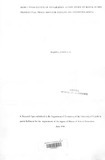| dc.description.abstract | Kenya's external trade is significant in its economic and political development. From
its exports, Kenya gets the foreign exchange required to import the goods necessary for its
development, but which it has not been able to produce with its present level of technological
and other resource endowments. The activities from which its export goods and services come
generate employment opportunities for its fast growing population. By trading with the out ide
world, Kenya is able to have mutual relations with its trading partners, the results of which have
enabled it to procure aid in the form of loans, grants and technical assistance from friendly
countries like the United Kingdom, West Germany, Japan and the USA an the donor agencies.
The donor agencies include the 1\1F and the World Bank. These have been important for its
development. It was a party to the Lome I, II, Ill, and IV of 1975, 1979, 1984 and 19 9
respectively and the Arusha Agreement of 1975 by which its exports receive preferential
treatment in the EEC market. On various occasions, it has had bilateral trade agreements with
foreign countries in an effort to raise the level of commercial intercourse with these countries,
but more so to accelerate its export flows to these countries. Yet not its trade with all countries
have been impressive. Its imports from the developed west have over the years continued to
outweigh its exports to these countries. In spite of this, much of Kenya's trade is still directed
to these countries. Its trade as a percentage of its GDP has been less than 30% since 1964.
This has not been able to save it from the scarcity of foreign exchange.
Its adoption of the Import Subst'hotio~ development strategy in the late 19605 and in
the 1970s made some contribution in saving foreign exchange and generating employment
opportunities in the country. However, the strategy had a limit beyond which it could not be
pushed. The production of consumer goods as a first stage of this strategy was quite a success
but because of a limited market, the production of intermediate goods and capital goods could
not be carried on with case. This strategy could not live upto its expectations because of the
market constraint. Another complementary strategy was therefore necessary to enable Kenya
to earn and save foreign exchange, false its level of capacity utilization and alleviate the
unemployment situation. Cooperation or integration In the Eastern and Southern African
subregion was readily available. Kenya did not hesitate to join this scheme with high hopes.
It was the intention of this study to establish what has accrued to Kenya from the PTA
over the short span of time during which it has been a member of this scheme. Both the
approaches used established that PTA has, at best, had erosive effects on Kenya's trade flows.
This is possibly because the PTA is still at its early stage of integration. I n addition to this, the
protectionist practices by the PTA countries and the harsh political environments in some
neighbouring countries, may account for this phenomenon. Little Gross Trade Creation was
evident. The External Trade Creation reflected by both approaches indicate that the PTA has
not redirected Kenya's trade flows. The study however underscores the essence of expediting
trade liberalization and market information campaign within the subregion to facilitate
increased intra-PTA trade. | en |

